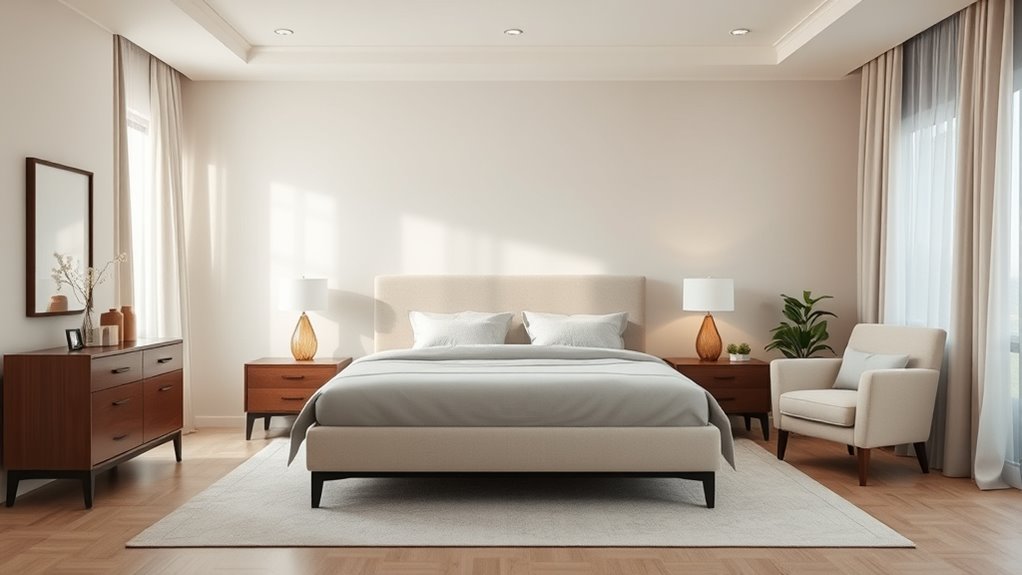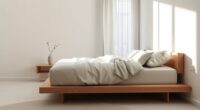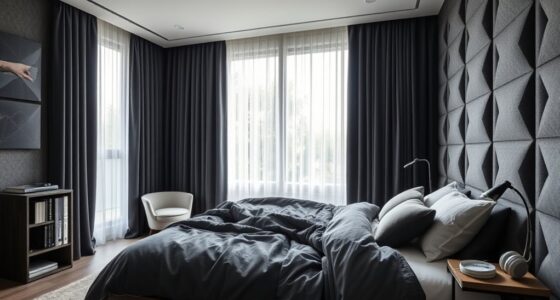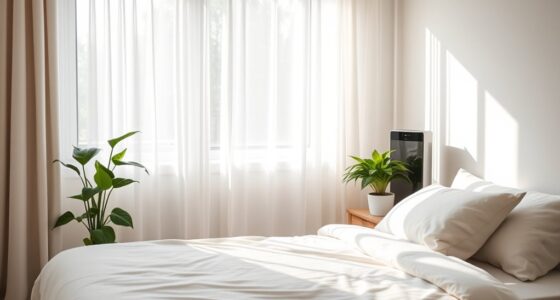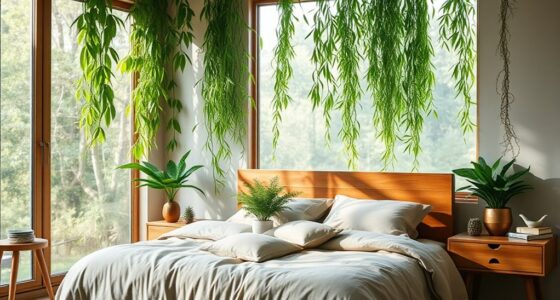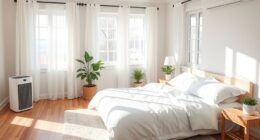To organize your bedroom for better sleep flow, start by clearing clutter and removing unnecessary items to create a calm space. Position your bed away from direct door lines and avoid blocking windows. Choose furniture that fits well without crowding, and incorporate hidden storage options to keep surfaces tidy. make certain pathways are clear for easy movement and accessibility. Keep a cozy, relaxing color scheme. If you continue exploring, you’ll discover practical tips to maximize your room’s tranquility and functionality.
Key Takeaways
- Arrange furniture to create clear, unobstructed pathways of at least 24 inches for easy movement.
- Position the bed away from the door and windows to promote a sense of security and relaxation.
- Keep bedside tables and lamps within easy reach without cluttering the space.
- Select appropriately sized furniture that fits the room without overcrowding.
- Use storage furniture to reduce visible clutter and maintain a calm, organized environment.
Assessing and Clearing Clutter for a Calm Space

Have you ever stepped into your bedroom and felt overwhelmed by the clutter? Clearing unnecessary items is the first step toward creating a calm space. Start by sorting through your belongings, setting aside what you no longer need or use. As you declutter, consider how decorative accents can enhance your room’s serenity—simple pieces that add personality without crowding. Pay attention to your lighting arrangements; removing excess lamps or tangled cords can make the space feel more open and inviting. Keep surfaces clear and organized, so your bedroom promotes relaxation. A tidy environment reduces stress and sets the tone for better sleep. Remember, less clutter means more space to breathe, helping you create a peaceful retreat you’ll look forward to entering. Proper organization techniques can also improve your room layout and optimize airflow for a more comfortable environment.
Optimizing Bed Placement for Better Sleep Flow

To create a more restful environment, focus on optimizing your bed placement to improve sleep flow. Position your bed so it’s not directly in line with the door, which can cause a feeling of vulnerability, and avoid blocking windows or vents. Consider how your lighting arrangement affects the space; placing your bed to minimize exposure to harsh or bright lights helps create a calming atmosphere. Additionally, think about your color scheme; soothing hues like soft blues or neutrals can enhance relaxation and make the space feel more balanced. Keep the area around your bed clear of clutter and furniture that disrupts movement. By thoughtfully placing your bed with these elements in mind, you foster a tranquil flow that promotes better sleep. Incorporating comfortable, ergonomic designs in your bedroom furniture can further enhance relaxation and support restful sleep.
Choosing and Arranging Essential Furniture Pieces
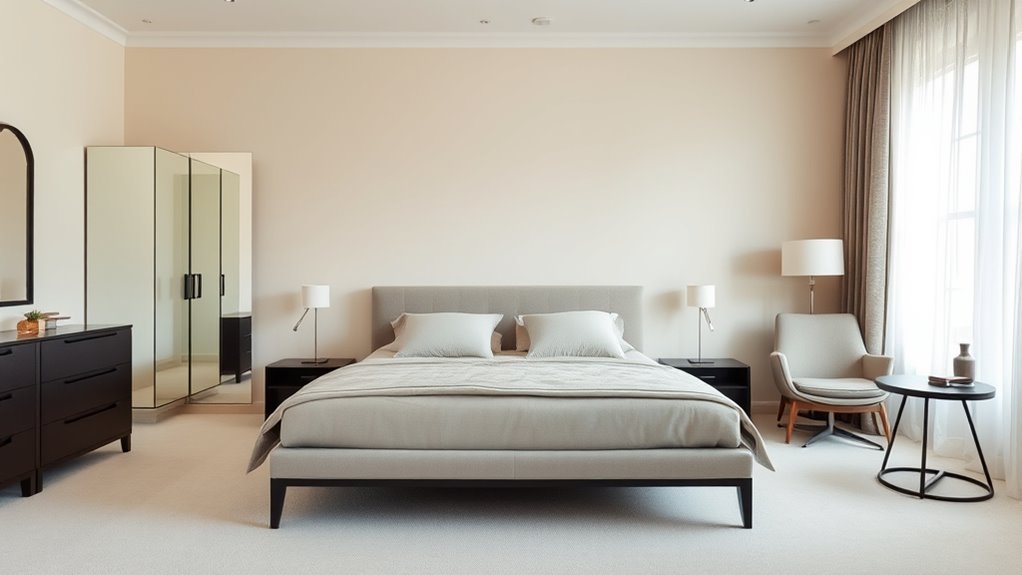
Selecting the right essential furniture pieces sets the foundation for a functional and comfortable bedroom. Focus on your bed, dresser, and nightstands, ensuring they fit your space without overcrowding. When choosing these pieces, consider decorating accents like lamps or artwork to add personality. Proper color coordination between furniture and accents creates a cohesive look that promotes relaxation. Opt for a bed with a sturdy frame and comfortable mattress to support restful sleep. Keep storage in mind with a dresser that offers ample space without dominating the room. Arranged thoughtfully, these essentials will enhance flow and accessibility, making your bedroom both inviting and practical. Remember, balancing style with function is key to creating a space that promotes better sleep and a calming atmosphere. Incorporating room organization strategies can further optimize your space for comfort and efficiency.
Creating Pathways and Accessibility in Your Bedroom
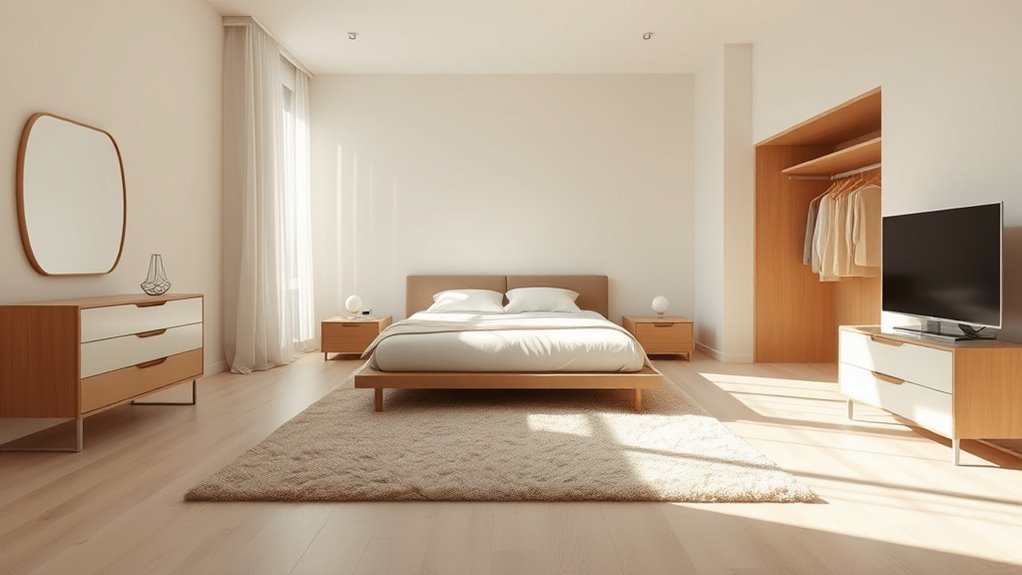
Creating clear pathways and ensuring easy accessibility are essential steps in organizing your bedroom. Start by carefully arranging furniture to avoid obstructions, keeping walkways at least 24 inches wide. Proper nightstand placement is key; position them within easy reach from your bed without blocking movement or access to other furniture. Consider your lighting arrangement as well—place lamps and switches where you can easily turn them on and off without stepping into the dark or tripping over furniture. Keep pathways free of clutter, cords, or decorative items that could cause tripping hazards. By thoughtfully planning these elements, you create a bedroom that’s both functional and inviting, promoting a smoother sleep flow and minimizing strain during your nightly routines.
Incorporating Storage Solutions to Minimize Distractions
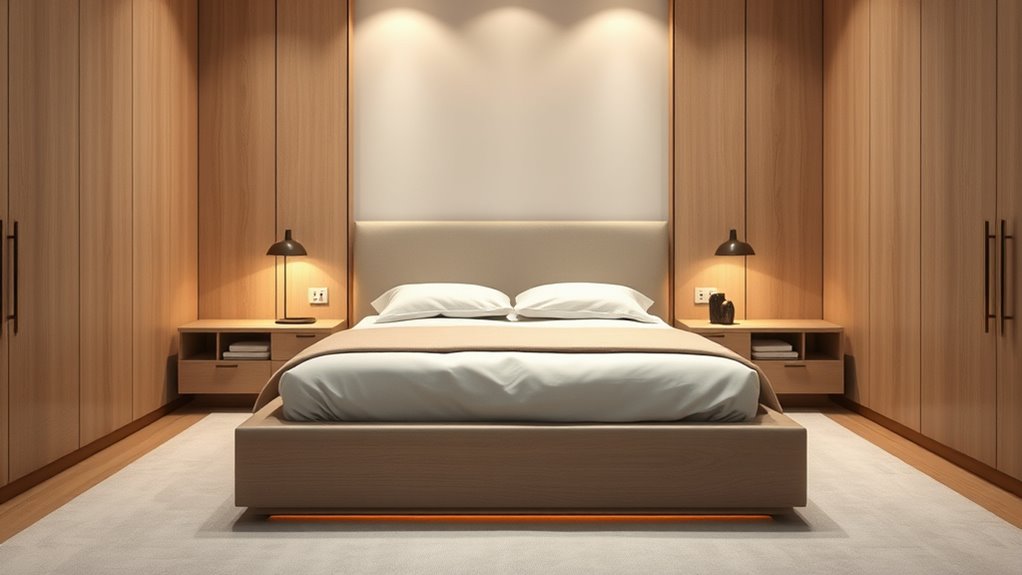
Incorporating effective storage solutions is essential for reducing visual clutter and promoting a calm, focused bedroom environment. Use hidden storage options, like under-bed drawers or wall-mounted shelves, to keep decorative accents and personal items out of sight. Organize your space with furniture that doubles as storage, such as beds with built-in drawers or storage ottomans. Proper lighting arrangements, like bedside lamps with concealed compartments, can also hide clutter and create a soothing ambiance. Here’s a quick overview:
| Storage Type | Best Use | Visual Impact |
|---|---|---|
| Under-bed drawers | Store seasonal clothing or linens | Keeps floor clear, minimizes distractions |
| Wall-mounted shelves | Display decorative accents neatly | Adds style without clutter |
| Bedroom chests | Store accessories and essentials | Reduces visual noise |
| Hidden compartments | Conceal electronics and chargers | Maintains a tidy look |
Additionally, integrating storage organization strategies can further enhance the overall harmony of your space.
Frequently Asked Questions
How Does Lighting Affect Sleep Flow in Bedroom Layout?
Lighting plays a vital role in your sleep flow by regulating your circadian rhythm. Proper lighting placement guarantees you’re not exposed to harsh artificial light before bed, helping you unwind. Maximize natural light during the day by placing your bed near windows, which boosts your mood and melatonin production. Dimming or avoiding bright lights at night supports better sleep, creating a calming environment that promotes restful sleep patterns.
What Are the Best Colors to Promote Restful Sleep?
When choosing colors to promote restful sleep, you should focus on calming hues rooted in color psychology. Soft blues, gentle greens, and muted neutrals are ideal because they create a soothing environment that eases your mind and relaxes your body. These calming hues help reduce stress and anxiety, making it easier for you to fall asleep and stay asleep throughout the night. Opt for these colors to enhance your sleep quality naturally.
How Can Soundproofing Improve Bedroom Sleep Quality?
You might think soundproofing isn’t necessary, but it truly enhances sleep quality by reducing disruptive noises. The soundproofing benefits include creating a peaceful environment, helping you fall asleep faster and stay asleep longer. Using noise reduction techniques like thick curtains, door seals, or acoustic panels can considerably block out external sounds. This quiet space minimizes disturbances, allowing you to wake up refreshed and improves overall sleep health.
What Role Does Airflow and Ventilation Play in Sleep Comfort?
Airflow and ventilation are key to your sleep comfort because they guarantee good air circulation, which improves air quality. When you have proper airflow, stale air is replaced with fresh air, helping to regulate temperature and humidity. This prevents stuffiness and reduces allergens, making your bedroom more comfortable. You’ll breathe easier and sleep better because your environment stays fresh and inviting throughout the night.
How Can Plants Be Incorporated Without Disrupting Sleep Flow?
You can incorporate plants into your bedroom by thoughtfully placing air purifying plants near windows or on shelves, ensuring they don’t block pathways or airflow. Select plants like snake plants or pothos for their air purifying benefits, which improve air quality without disrupting sleep flow. Keep them away from your bed to prevent any potential disturbances, and choose low-maintenance varieties to maintain a calming, organized space.
Conclusion
By transforming your bedroom into a clutter-free sanctuary, you’ll create a sleep haven so peaceful, it’s like floating on a cloud of serenity. With perfectly placed furniture and clear pathways, your sleep flow will be smoother than a river in full flood. Say goodbye to chaos and hello to a bedroom so organized, even a tornado couldn’t turn it upside down. Get ready for nights so restful, you’ll feel like you’ve slept for a hundred years!
